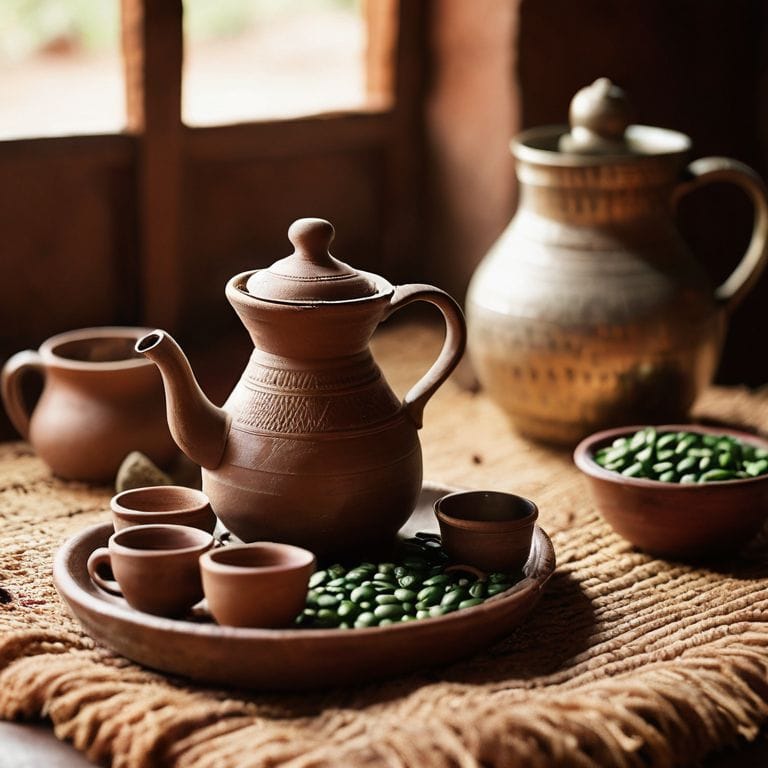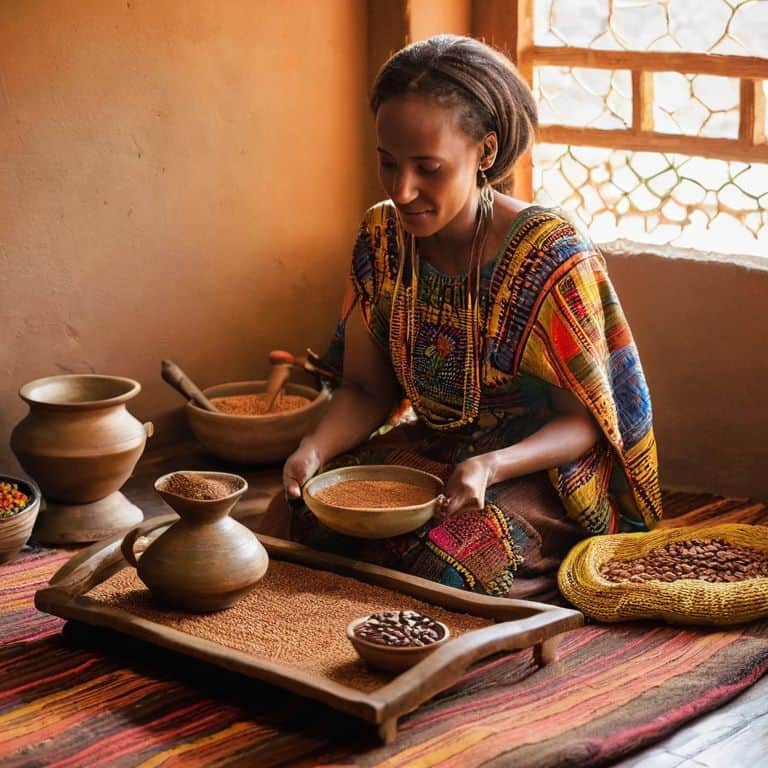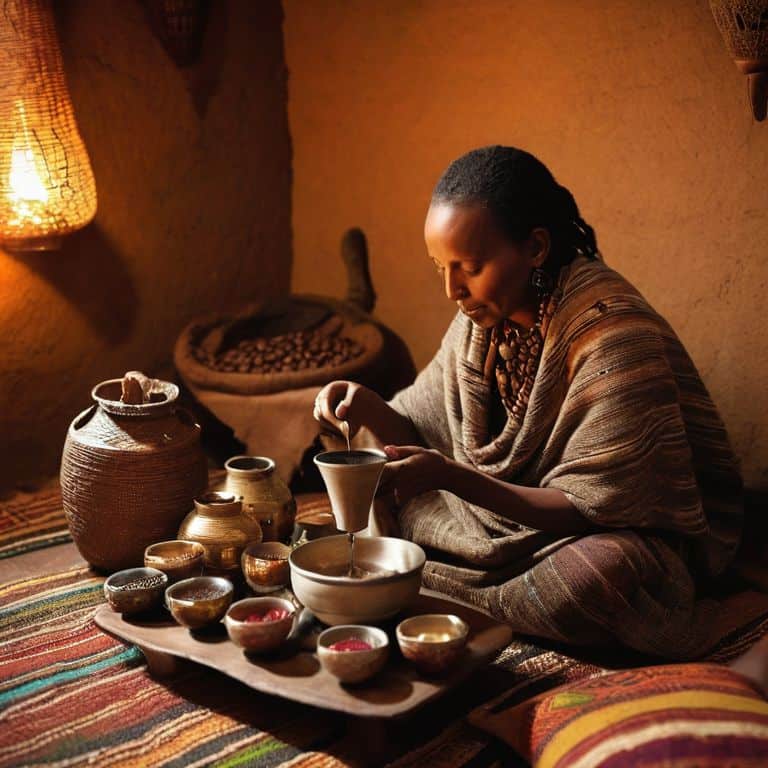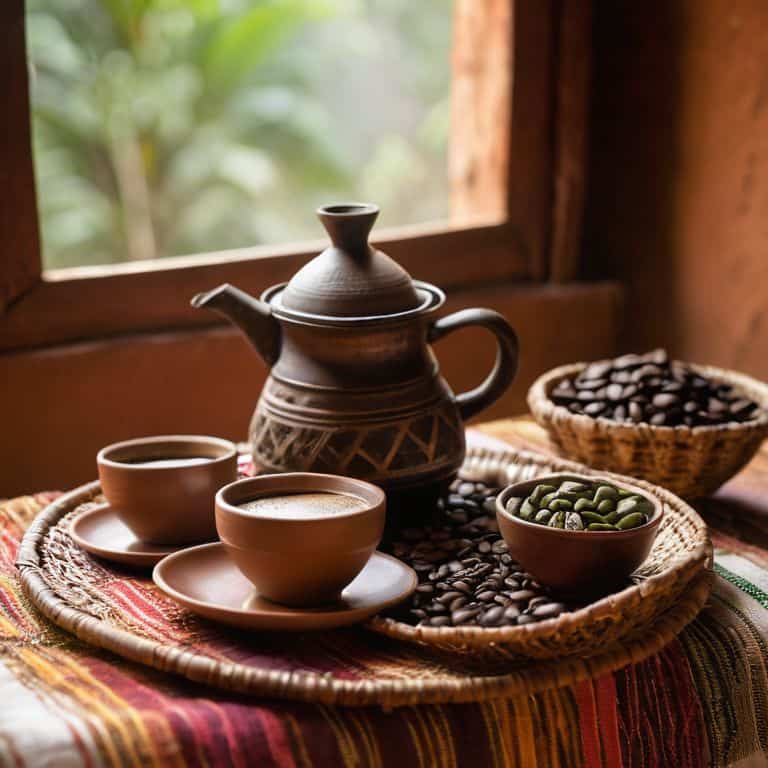As I sit here, surrounded by the warm aromas of freshly brewed coffee, I am reminded of my first encounter with the Ethiopian coffee ceremony. It was as if I had stumbled upon a hidden gem, a tradition that was both familiar and exotic. The ceremony, with its intricate rituals and rich flavors, left an indelible mark on my heart. And yet, I’ve often found that when people talk about a guide to the Ethiopian coffee ceremony, they reduce it to a series of sterile steps, stripping it of its soul. But the truth is, this ceremony is so much more than just a ritual – it’s an experience that weaves together community, culture, and culinary delight.
In this article, I promise to take you on a journey that will transport you to the heart of Ethiopia, where the coffee ceremony is a revered tradition. You’ll learn the essence of this ceremony, from the selection of the finest coffee beans to the delicate nuances of the brewing process. My goal is to provide you with a practical and immersive guide that will allow you to recreate this enchanting experience in the comfort of your own home. By the end of this journey, you’ll have gained a deeper appreciation for the rich cultural heritage behind a guide to the Ethiopian coffee ceremony, and you’ll be equipped with the knowledge to host your own unforgettable coffee ceremonies.
Table of Contents
- Guide Overview: What You'll Need
- Step-by-Step Instructions
- A Guide to the Ethiopian Coffee Ceremony
- Deciphering Coffee Ceremony Etiquette and Jebena Pot Lore
- Unlocking Traditional Ethiopian Coffee Roasting Secrets
- Steeping in Tradition: 5 Essential Tips for a Authentic Ethiopian Coffee Ceremony Experience
- Essence of the Ethiopian Coffee Ceremony: 3 Key Takeaways
- Unpacking the Essence of Ethiopian Coffee
- Reflections on the Timeless Ethiopian Coffee Ceremony
- Frequently Asked Questions
Guide Overview: What You'll Need

Total Time: 1 hour 15 minutes
Estimated Cost: $20 – $30
Difficulty Level: Easy
Tools Required
- Jebena or Clay Coffee Pot (traditional Ethiopian coffee pot)
- Coffee Grinder (manual or electric)
- Incense (optional, for traditional atmosphere)
- Small Table or Tray (for serving)
- Cups (small, traditional Ethiopian coffee cups)
Supplies & Materials
- Green Coffee Beans (Ethiopian Yirgacheffe or other traditional variety)
- Sugar (or traditional Ethiopian honey)
- Water
- Snacks (traditional Ethiopian snacks, such as injera or roasted barley)
- Fresh Flowers (optional, for decoration)
Step-by-Step Instructions
- 1. To begin the Ethiopian coffee ceremony, gather essential items such as a traditional clay coffee pot called a “jebena,” a coffee roasting pan, a mortar and pestle, and small cups. I recall my first experience with this ceremony, where the aroma of freshly roasted coffee beans filled the air, and the sound of laughter and chatter created a warm atmosphere.
- 2. Next, select and roast the coffee beans. In Ethiopia, it’s customary to use green coffee beans, which are then roasted in the coffee roasting pan over an open flame. This process is not just about preparing the beans for brewing but also about creating an immersive experience. As I watched the beans transform from green to a rich brown, I felt a sense of anticipation building, much like the art of storytelling that unfolds during these ceremonies.
- 3. Once the beans are roasted to perfection, remove them from the heat and let them cool slightly. Then, use the mortar and pestle to grind the beans into a fine powder. This step is crucial, as the grind of the coffee affects the flavor and aroma of the final brew. I find that the manual grinding process allows for a moment of reflection, much like the quiet moments one finds in old, historic cafes.
- 4. With the coffee grounds ready, it’s time to brew the coffee. Fill the jebena with water, add the ground coffee, and place it over the open flame. As the coffee brews, the aroma will fill the air, and the sound of the coffee bubbling will signal that it’s ready. I often think of this step as the heart of the ceremony, where the elements come together to create something truly special.
- 5. While the coffee is brewing, prepare the snacks and refreshments that will accompany the ceremony. Traditional Ethiopian snacks include popcorn, roasted barley, or small pastries. These snacks not only complement the coffee but also serve as a symbol of hospitality and community. As I share these snacks with others, I’m reminded of the power of food to bring people together.
- 6. Once the coffee is ready, serve it in the traditional small cups. The coffee is typically served in three rounds, with each round representing a different aspect of life: the first round for peace, the second for prosperity, and the third for love. As I participate in this ritual, I feel a deep connection to the cultural heritage that underlies this ceremony.
- 7. Finally, engage in conversation and enjoy the company of those around you. The Ethiopian coffee ceremony is as much about the coffee as it is about the people and the stories shared during the ritual. As I sit with friends and strangers alike, sipping the rich, flavorful coffee and listening to their tales, I’m reminded of the beauty of human connection that this ceremony embodies.
A Guide to the Ethiopian Coffee Ceremony

As I delve deeper into the world of Ethiopian coffee, I’m reminded of the traditional Ethiopian coffee roasting methods that bring out the unique flavors of each bean. The art of roasting is a sensory experience, with the aroma of freshly roasted coffee filling the air and tantalizing the taste buds. When attending a coffee ceremony, it’s essential to understand the coffee ceremony etiquette, which emphasizes respect, community, and a deep appreciation for the coffee itself.
The jebena coffee pot is an integral part of the Ethiopian coffee tradition, and its maintenance is a testament to the country’s rich coffee culture. To ensure the perfect brew, it’s crucial to clean and maintain the jebena regularly, allowing the coffee to flow smoothly and evenly. As I sit in a traditional Ethiopian coffee shop, surrounded by the vibrant colors and lively chatter, I’m struck by the social significance of coffee in Ethiopia, which brings people together and fosters a sense of community.
In Ethiopia, coffee is often paired with traditional snacks, such as injera or ambasha, to create a delightful Ethiopian coffee and food pairing experience. The bitterness of the coffee is balanced by the sweetness of the snacks, creating a harmonious union of flavors. As I sip my coffee and savor the local delicacies, I’m grateful for the opportunity to immerse myself in the buna coffee recipes and traditions that have been passed down through generations, and to share this rich cultural heritage with others.
Deciphering Coffee Ceremony Etiquette and Jebena Pot Lore
As I sat in a traditional Ethiopian home, surrounded by the warm scent of roasting coffee, I was struck by the intricate etiquette that governs the coffee ceremony. It’s a dance of respect and hospitality, where every gesture, from the way the coffee beans are presented to the manner in which the cups are filled, holds deep significance. The jebena pot, with its distinctive neck and handle, is more than just a vessel – it’s a symbol of the ceremony’s rich history and cultural heritage.
I recall being enchanted by the stories of my host, who spoke of the jebena pot as a keeper of secrets and a witness to countless gatherings and celebrations. As the coffee flowed, so did the conversations, and I felt as though I was unraveling the threads of a timeless tradition. The jebena pot, it seemed, was not just a tool, but a key to unlocking the very heart of Ethiopian hospitality.
Unlocking Traditional Ethiopian Coffee Roasting Secrets
As I delved deeper into the Ethiopian coffee ceremony, I became fascinated by the traditional roasting techniques that bring out the distinct flavors of their prized coffee beans. The aroma of freshly roasted coffee still wafts through my memory, transporting me to the bustling markets of Addis Ababa. I recall watching in awe as the host carefully roasted the green coffee beans in a shallow pan over an open flame, stirring constantly to achieve the perfect balance of smokiness and sweetness. This labor of love is a testament to the Ethiopian devotion to their coffee culture.
The traditional roasting process is an art form, with each region boasting its own unique methods and secrets. From the highlands of Sidama to the plains of Yirgacheffe, every bean tells a story of the land, the people, and the traditions that have been passed down through generations. As I sipped the rich, full-bodied coffee, I felt a deep connection to the land, the culture, and the people who had carefully crafted this exquisite brew.
Steeping in Tradition: 5 Essential Tips for a Authentic Ethiopian Coffee Ceremony Experience
- Impress your hosts by learning a few basic Amharic phrases, such as ‘betam konjo’ (welcome) and ‘betam tikkieh’ (good taste), to show respect and appreciation for the traditional ceremony
- Choose the right green coffee beans, as Ethiopian coffee is known for its distinctive floral and citrus notes, and freshly roasting them in a traditional clay roasting pan will elevate the entire experience
- To create an immersive atmosphere, adorn the room with traditional Ethiopian textiles, such as vibrant woven baskets and intricately patterned scarves, which will add a pop of color and cultural significance to the ceremony
- Pay attention to the Jebena pot, as the way it’s handled and poured is an art form in itself – the host will typically pour the coffee in a thin stream from a height of about 10-15 inches, creating a delightful crema on top of each cup
- As you sip your coffee, remember that the ceremony is as much about the company as it is about the coffee, so take the time to engage in lively conversations, share stories, and forge meaningful connections with your fellow participants, just as the Ethiopians do
Essence of the Ethiopian Coffee Ceremony: 3 Key Takeaways
I’ve found that the traditional Ethiopian coffee ceremony is more than just a ritual – it’s a sensory journey that weaves together the aromatic scents of freshly roasted coffee, the vibrant colors of native flowers, and the warmth of community, all of which are deeply rooted in the country’s rich cultural heritage
The intricate process of roasting green coffee beans over an open flame, followed by the deliberate and ceremonial grinding by hand, is a testament to the Ethiopian people’s reverence for coffee as a symbol of hospitality, friendship, and intellectual discourse, echoing the timeless ambiance of Vienna’s legendary coffeehouses where I spent countless hours researching for my thesis
Through my travels and research, I’ve come to realize that mastering the Jebena pot and deciphering the nuances of coffee ceremony etiquette are not merely about technical proficiency, but about embracing the spirit of togetherness and respectful dialogue that this ancient tradition embodies, much like the urban sketching sessions I’ve had in historic cafes, where the gentle clinking of cups and the soft hum of conversation blend in perfect harmony
Unpacking the Essence of Ethiopian Coffee
The Ethiopian coffee ceremony is more than a ritual, it’s a sensory tapestry woven from the threads of tradition, community, and the gentle warmth of human connection – a reminder that, in the simplest of moments, we find the deepest of meanings.
Isabella Marino
Reflections on the Timeless Ethiopian Coffee Ceremony

As I reflect on the Ethiopian coffee ceremony, I am reminded of the rich cultural heritage that underlies this ancient tradition. From the meticulous process of traditional Ethiopian coffee roasting to the nuanced etiquette surrounding the jebena pot, every aspect of the ceremony is steeped in history and significance. My journey through the steps of this ceremony, from the initial preparation to the final serving, has been a fascinating exploration of the senses and the human spirit. Whether you are a seasoned coffee connoisseur or simply a curious traveler, the Ethiopian coffee ceremony offers a unique glimpse into the country’s warm hospitality and vibrant culture.
As I sit here, sipping my own cup of coffee, I am filled with a sense of wonder and appreciation for the simple yet profound joys of this daily ritual. The Ethiopian coffee ceremony is more than just a tradition – it is a celebration of community and a testament to the power of coffee to bring people together. So let us cherish this ceremony, and the stories it tells, as we continue to explore the enduring magic of coffee and its ability to transcend borders and cultures, one cup at a time.
Frequently Asked Questions
What is the significance of the Jebena pot in Ethiopian coffee ceremonies and how does it contribute to the unique flavor profile?
The Jebena pot is the heart of Ethiopian coffee ceremonies, its clay body imparting a distinct, earthy flavor to the coffee. As I’ve witnessed in countless ceremonies, the Jebena’s gentle curves and narrow spout allow for a precise, high-temperature pour, bringing out the full-bodied notes of the coffee, a true marvel of traditional craftsmanship.
How do I properly participate in an Ethiopian coffee ceremony as a guest, and what are the key etiquette rules to keep in mind?
As a guest, participate with reverence and curiosity. Arrive early, dress modestly, and greet the host with a respectful bow. Sit on the floor, and when offered, accept the coffee with both hands, saying “betam konjo” (very good). Engage in conversation, and don’t rush – the ceremony is a sensory journey, not a hurried affair.
Can I recreate the traditional Ethiopian coffee roasting process at home, and if so, what equipment and techniques would I need to use?
Recreating the traditional Ethiopian coffee roasting process at home is indeed possible. I’ve found that a simple skillet or a dedicated coffee roaster can help you achieve that distinctive smoky flavor. Key techniques include heating the beans to the right temperature and constantly stirring to prevent burning, just as I learned from the artisans in Addis Ababa.



